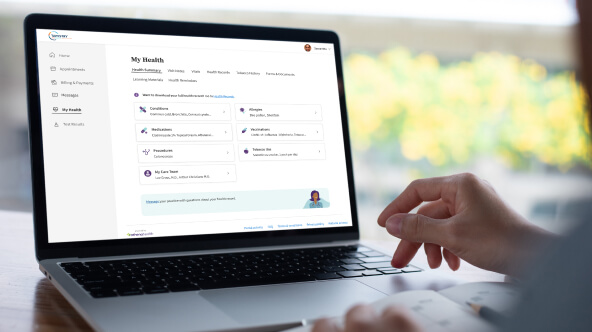We rebuilt our digital self check-in solution from scratch. Here’s why.
For the modern practice, digital self check-in isn’t optional, it’s foundational. Patients expect to be able to connect with their doctor’s office the same way they access consumer services of all kinds: from the convenience of their mobile phone or computer. You need to be able to meet – or better yet, exceed – patients’ expectations in a digital-first environment. At athenahealth, we can help.
With Enhanced Self Check-In (ESCI), athenahealth’s best-of-breed digital patient engagement offering lets patients securely complete their check-in tasks wherever they are via their preferred digital point of entry. The design and workflow are user-friendly and accessible to all patients. For practices, new levels of efficiency and the newest technology mean your staff will have the outstanding experience they deserve, now and for years to come with each improvement we make.
We’ve prioritized our digital patient engagement tools because we know that an intuitive, easy-to-use, and empowering interaction with your practice can set the tone for successful practice-patient relationships. That’s good for patients and good for the health of your practice, too.
What is Enhanced Self Check-In?
Enhanced Self Check-In replaces traditional check-in workflows with a fully integrated experience embedded within the athenaOne® electronic health record, practice and revenue cycle management, and digital patient engagement solution. It allows patients to securely complete check-in steps remotely or in the office, reducing administrative burden on staff and improving data accuracy. The patient-centric interface was designed to be as user-friendly as possible for patients at all levels of tech literacy.
Rebuilding ESCI from scratch enables us to make the most of modern technology. We’ll be able to iterate on our digital patient engagement solution faster, bringing new features to market more quickly. As always, when patients provide their check-in data, those inputs flow into athenaOne as structured data, not as PDFs for a staff member to manually copy into the electronic health record and potentially introduce mistakes.
Empowering patients to set up their own payment plans is a valuable way to help increase patient pay yield.
A simpler experience for patients. More flexibility and efficiency for practices.
Enhanced Self Check-In includes flexible new features to support patient and practice health now, with additional enhancements planned for release later in the year.
- Digital Patient Forms: Practices can now create customizable, fully interactive forms for patients to complete digitally. These forms automatically update patient records in athenaOne, eliminating manual data entry work and helping to reduce errors.
- Insurance Card Image Capture: To help staff verify patients’ insurance eligibility before the appointment, patients can upload photos of their insurance cards directly to the EHR. AI-powered analysis suggests the correct insurance package, saving time and reducing manual verification efforts.
- Comprehensive Health Histories: Every practice collects a spectrum of patient health histories. Enhanced Self Check-In supports detailed collection of social, surgical, past medical, family, allergy, gynecological, and medication histories. This data flows into a reconciliation workflow, enabling staff to update records efficiently, which in turn supports better clinical decision-making.
- Extensive Screening Questionnaires: athenaOne now offers more than 115 screeners, so practices can tailor patient questionnaires to meet clinical needs. These screeners are developed by clinical content and safety teams, and customers can request others as needed.
- Medication History and Pharmacy Management: Patients can now select up to 5 preferred pharmacies, including a primary pharmacy, helping practices maintain accurate records and improve care coordination.
- Payments and Payment Plans: Empowering patients to set up their own payment plans is a valuable way to help increase patient pay yield. Enhanced Self Check-In now allows patients to set up automated payment plans as they view and pay their outstanding balances. The result: more patient pay collected with fewer errors.
- Staff-Initiated Check-In: Not every patient has a smartphone or wants to use it to check in. With athenaOne, that won't be a problem. Practice staff will be able to use a practice-owned device to have patients complete self check-in while in the waiting room. (For those patients who do have a smartphone but who arrive without checking in, staff can now send a personalized link to their phone to check in while they wait.)
- Coming soon - Primary Insurance Filters for Digital Patient Forms: Every health insurance plan, or payer, has its own requirements for what member data it requires and how often it needs to collect the data. Soon your practice will be able to create payer-specific forms for that payer’s members to complete. We’ve made these forms easy to configure to save your staff time and effort.
Why choose Enhanced Self Check-In?
Enhanced Self Check-In is more than a digital patient engagement tool; it’s a strategic asset that enhances patient engagement, reduces administrative workload, and improves data quality. Its integration within athenaOne ensures seamless data flow, supporting both clinical and operational workflows. For practices looking to modernize and optimize patient intake, ESCI offers a scalable, user-friendly solution with multiple points of entry to meet the needs of diverse patient populations.
By adopting Enhanced Self Check-In, practices position themselves at the forefront of healthcare innovation, delivering a smoother, more efficient experience for patients and staff alike. Best of all, Enhanced Self Check-In is built into athenaOne – there is no additional cost to customers.
Next steps: Explore our digital patient engagement tools
Read how Tapestry 360 Health of Chicago uses athenaOne to increase patient engagement while reducing administrative burden.
Request your personalized demo of athenaOne and our digital patient engagement solution.













